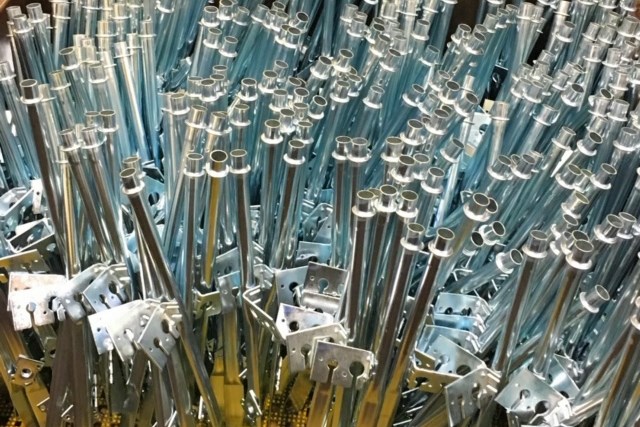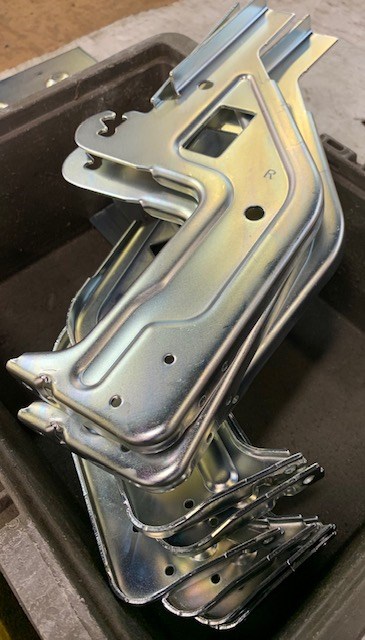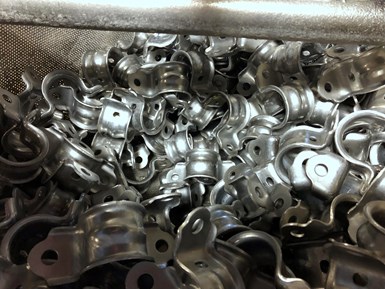Inside Zinc and Zinc-Nickel Post-Plating Protective Finishes
A behind-the-scenes look at post-plating finishes for zinc and zinc-nickel plating.

Asterion acid zinc and trivalent passivate are used on a variety of cold-form fittings and pipes. Photo courtesy of APCOM (Franklin, Tenn.)
When I began my career in metal finishing in the mid-1980s, the industry took an introspective view of where it came from and in what direction it was going. It is interesting to look back at that time and remember all of the changes that began occurring as we entered the 1990s. Environmental concerns dominated the industry. I can specifically remember the market being flooded with new technology and equipment to deal with environmental concerns about the plating process. This was followed by developments in plating technology that addressed global concerns about the air and water pollution associated with the disposal of the plated product at the end of its life. The challenge presented to proprietary chemical formulators was to develop environmentally friendly processes that met the demand for corrosion-resistant finishes.
Fast forward to today. The industry, as a whole, has adapted very well at providing OEMs in various industries with finishes that comply with strict environmental standards, while also meeting very challenging corrosion resistance requirements.
Arguably, in recent years, the most attention given to new and improved technology for post-plating finishes has been directed at zinc and zinc-nickel plating. The driving force for new development has been the automotive industry. Accelerated corrosion tests such as salt spray tests, mud tests, gravel road tests, and temperature and humidity tests, among others, attempt to simulate real-world conditions to give companies a performance barometer by which to measure the improvement of the corrosion performance of their products.

Asterion acid zinc with a trivalent passivate provides excellent ductility and adhesion. Source | Asterion
Zinc plating
In addition to the thickness of the zinc plating, a post-treatment process is necessary to provide an enhanced corrosion-resistant finish. The finish is chosen based on the customer’s requirements.
Chromates (passivates)
In common conversation, the terms chromate and passivate are used interchangeably, although they technically differ. A chromate is a conversion coating in which hexavalent chrome reacts with a zinc finish in order to convert that finish into a protective coating. Passivates were developed in response to the drive to remove hexavalent chrome from the production process and the finished part. The pH values of trivalent passivates are low, typically operating between 1.8 and 2.5. Passivates are complex chemical processes that contain metals, accelerators, oxidizers and complexors. Trivalent passivates may be divided into two categories: thin and thick film.

Asterion alkaline zinc with a trivalent passivate and an organic seal used on complex stampings. Source | Asterion
Thin-film trivalent passivates are specified to provide a thin trivalent chrome coating over the plated zinc finish. Cobalt is sometimes added to the passivate formulations to provide additional corrosion resistance. European directives to eliminate the use of cobalt have led to recent developments of new alternatives that are cobalt-free. The corrosion-resistant performance relies on several factors in the production process, such as the effectiveness of the nitric acid bright dip before the passivate process, concentration of the passivate process, pH, time in the process, temperature of the bath, quality of the plated deposit, level of impurities in the passivate bath, degree of cleanliness of the rinse tanks and successful drying of the parts. Thin-film passivates typically operate at ambient temperatures and deposit a noticeably thinner coating than the thick-film products. Passivate film thickness ranges from 1 micron or more for thick-film passivates to less than half a micron for thin-film passivates.
Normally, the thin-film passivates produce a bluer appearance than the thick-film passivates.
Thick-film passivates are typically heated and contain a higher concentration of metal salts. Because of their thickness, these passivates generally provide more corrosion resistance at a lower cost since it is not necessary to add additional materials to meet performance requirements.

High-volume barrel operation that employs an Asterion alkaline zinc-nickel system. The parts exhibit uniform distribution and high throw capabilities. Photo courtesy of Wisconsin Plating Works (Racine, Wisc.)
Zinc-nickel plating
There are several noticeable differences in the application of post-treatments for zinc-nickel plating. After the deposit is plated, a non-oxidizing acid is used to activate the surface prior to the passivate process.
Passivates
Although zinc-nickel finishes are very corrosion-resistant as plated, a passivate is recommended to add an additional layer of protection to assist with mitigating the initiation of white corrosion product. Typical zinc-nickel passivates can produce either a clear bluish finish or a black finish. In some circumstances, the clear bluish finish is treated with a subsequent sealer to enhance corrosion protection. Black passivates are almost always subsequently treated with a post-finish sealer which promotes the functional and aesthetic properties of the finish. The pH values of the passivate bath generally range between 3.0 and 4.0 for a clear bluish finish and between 2.0 and 2.5 to produce a black finish. The passivate processes recommended for zinc-nickel are thin-film formulations.

Asterion acid zinc system with a trivalent passivate and an organic seal used on threaded fasteners. Photo courtesy of NuTec Metal Finishing (Birmingham, Ala.)
Sealers
When a zinc or zinc-nickel finish is specified that requires corrosion protection beyond the capability of the passivate, an additional process is required. A clear sealer is specified to meet the demand for the increase in corrosion protection. Typically, zinc finishes will specify a sealer to boost corrosion protection to satisfy the demands of strict accelerated corrosion tests.
Silicated sealers have been in the market for many years and are considered very reliable as a clear topcoat over the passivated finish. The additional corrosion protection provided by these sealers in combination with the protection provided by the passivate and the low operating cost make these type of sealers a popular choice. Silicated sealers can be characterized as an amorphous glass coating which “seals” the passivate film very effectively. Silicated sealers do have a tendency to reduce the blue hue of a clear, bright blue passivate, producing an almost clear film. This process is a single-step final process after the passivate (and rinses after passivate). The process is typically heated in the tank. It should be noted that, if the part requires baking for hydrogen embrittlement, the silicate sealer should be applied after the baking cycle.
Organic nanoparticle sealers are the latest innovation in sealer technology. This unique process can be used in a single tank at the end of the line before drying. The process does not need to be heated, and operates at a slightly alkaline pH. Post-plate baking is acceptable. The sealer yields a clear film that has self-healing properties (similar to those of a hexavalent chromate) and a high modulus of elasticity, which is needed for parts that are crimped after plating. Another novel advantage to this sealer is its robust ability to tolerate the presence of impurities dragged into the passivate bath, such as on automatic high-volume machines.
Nanoparticle additives to passivate baths
In addition to the use of nanoparticle technology with organic sealers, another method to improve corrosion performance is the addition of specialized nanoparticles in the passivate bath. These nanoparticles are incorporated into the passivate film, which improves abrasion resistance as well as corrosion performance. When the nanoparticle passivate is followed by the organic nanoparticle sealer, it can result in performance that exceeds traditional standards. It should be noted that nanoparticles are not considered a sealer, however, they can be added to the passivate process to improve the performance of the passivate. This is a very viable option if space limitations prohibit a separate sealer tank, yet the specification for the part requires enhanced corrosion protection. The nanoparticle process is versatile and can be used in thin-film and thick-film formulations. If tank space is available, the passivate tank with the nanoparticle addition as well as the use of a final nanoparticle sealer can provide phenomenal corrosion protection over zinc-plated finishes. Most nanoparticle processes are not adversely affected by post-process baking.
Proprietary chemical suppliers continue to look into the future to provide corrosion-resistant technology that meets both increasingly stringent environmental requirements as well as the demand for improved corrosion resistance. As the Greek philosopher Heraclitus said, “The only thing certain is change.” Be prepared to stay ahead of the curve by staying on top of changing requirements and working with your proprietary chemical suppliers to meet the ever-evolving demands of the metal finishing market.
Related Content
Liquid Chrome Vs. Chromic Acid Flake
Contemplating how to continue offering chromic acid services in an increasingly stringent regulatory world? Liquid chrome products may be the solution you’re looking for.
Read MoreTrivalent Chrome Overview
As the finishing industry begins to move away from the use of hexavalent chromium to trivalent chromium, what factors should finishers consider as they make new investments? Mark Schario, chief technology officer for Columbia Chemical offers a helpful overview of this complicated topic.
Read MoreProducts Finishing Reveals 2023 Qualifying Top Shops
Each year PF conducts its Top Shops Benchmarking Survey, offering shops a tool to better understand their overall performance in the industry. The program also recognizes shops that meet a set of criteria to qualify as Top Shops.
Read MoreA Chromium Plating Overview
An overview of decorative and hard chromium electroplating processes.
Read MoreRead Next
Episode 45: An Interview with Chandler Mancuso, MacDermid Envio Solutions
Chandler Mancuso, technical director with MacDermid Envio discusses updating your wastewater treatment system and implementing materials recycling solutions to increase efficiencies, control costs and reduce environmental impact.
Read MoreDelivering Increased Benefits to Greenhouse Films
Baystar's Borstar technology is helping customers deliver better, more reliable production methods to greenhouse agriculture.
Read MoreA ‘Clean’ Agenda Offers Unique Presentations in Chicago
The 2024 Parts Cleaning Conference, co-located with the International Manufacturing Technology Show, includes presentations by several speakers who are new to the conference and topics that have not been covered in past editions of this event.
Read More










.jpg;maxWidth=300;quality=90)










